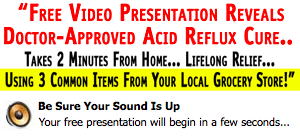November 9, 2010
pH Number of Stomach Acid
You may already understand pH, but let me quickly explain what pH level is for the sake of clarity.
The pH scale simply measures acid and alkalinity. The pH scale starts at the most acidic level of 0 and goes up to the most alkaline pH level of 14.
This makes the midpoint of pH 7 neutral.
Your electrolytes in your tissue are negatively charged mineral ions that create more electrons from the water you drink. These electrons control the perfect pH level to sustain life . . . ?at 7.4 pH.
If you have a disease your pH level will reflect this by showing an acidic pH below pH 7, the neutral mark.
The only place in your body that should normally have an acidic pH reading is in your stomach.
Every other organ, your bones and your blood must stay very close to pH 7.4.
Naturally stomach acid has a pH of about 2 and is made of about 0.5% of hydrochloric acid (HCL), large amounts of potassium chloride (KCL) and sodium chloride (NaCL).
If your stomach acid gets neutralized by antacids, you’ll experience acid indigestion, just the opposite of what you were told from the TUMS manufacturers.
It may surprise you that for more than a decade Swedish scientists have known that antacids cause more harm than good. Frankly, we’re finding out many pharmaceutical products are just profitable gimmicks at least and outright poisons at worst.
You see, more often than not acid reflux, heartburn and even gastro-esophageal reflux (GERD) disease are symptoms of a lack of sufficient stomach acid due to a very common electrolyte deficiency.
When I mention electrolytes, you probably think of Gaterade, right? That proves the power of corporate advertising right there. Gatorade is one of the lamest sources of electrolytes and isn’t any better than table sugar and salt, in fact personally I won’t touch the stuff.
Processed sugar dissolves your bones and refined salts build up in your kidneys. A better source would be what I call a smart person’s Gaterade:
- 1/2 teaspoon of RAW honey or cane sugar
- 1-2 teaspoons Celtic Sea Salt
- 2 liters of distilled water.
You can also use Agave nectar for a low glycemic load and coral calcium tea bags for the ocean minerals.
The point of the matter is you need a good source of charged ocean minerals and water; the sugar isn’t nearly as important, in fact I replace the sugar with lemon juice myself. Be sure you never drink alkalized (electrolyte) water with your meals. The minerals are alkaline, which means they can neutralize your stomach acid. So drink your two liters of ocean minerals between meals or at least an hour before you eat a large meal.
A balanced pH level means your body is properly energized and that your “terrain” or body tissues are supporting a strong immune system.
Viruses, harmful microbes and even cancer cells can NOT survive in an alkaline pH environment. On the other hand an acid pH environment is perfect for disease and foreign invaders to thrive in because it lacks stabile oxygen, is high in metabolic wastes and lacks antioxidant ocean minerals.
Bottom line, you need alkaline pH, life supporting ocean minerals, flowing through your tissues and organs in order to create a proper acid pH for your stomach acid. If your tissue had an acid pH and your stomach contents had an alkaline pH you wouldn’t even be alive very long, if at all.
pH balance is the secret of longevity and wellness!
You were born to heal,
Todd M. Faass?
Health Ecologist
Filed under Acid Reflux by admin
September 23, 2010
Gerd and Bronchitis
Many people suffer needlessly from a condition that keeps them awake at night?just from eating. That condition is referred to by many as heartburn, because it sort of feels like the area around your heart is burning. In reality, the stomach acid that digests your food is washing back up your esophagus in a movement called reflux. The medical name for this is called Gastro Esophogeal Reflux Disease?if it occurs more than a couple of times a week.
Often, people will refer to Gastro Esophogeal Reflux Disease as GERD, to simplify things. Others can become confused because GERD is also called Acid Reflux Disease, although the two are in fact the same. GERD is a big problem for many people and for good reason.
Stomach acid is very strong?it has to be in order to break down food and aid in the processes of your digestive system. When the stomach acid washes back up your throat, the acid eats at your esophagus, causing a little bit of damage each time. Your teeth also face damaging effects of this condition, as the enamel will slowly corrode over time.
One problem that GERD sufferers face is bronchitis. At first, the correlation between GERD and bronchitis does not seem obvious, but it is there. Each time that the stomach acid comes back up into the esophagus, the GERD sufferer faces the opportunity of choking. When someone chokes, they can inadvertently swallow the acid that they have just brought up. Aspiration of stomach acid makes for a good deal of pain coming up and an equal amount going down into your lungs.
There is much danger when stomach acid gets into your lungs?bronchitis. Due to the acid?s powerful nature, it can affect the inside of the lungs badly enough to inflame the bronchia, which can lead to bronchitis.
The tie between GERD and bronchitis can be limited with proper management and proactive effort. However, there has to be work done from both the patient and the doctor?although most of the work will be the patient.
Doctors of course, will have prescription medications available to give patients for management of their GERD, and the possible resulting bronchitis. There are some doctors that are beginning to push their patients towards using something other than medication to solve their problems with GERD.
Resolving issues within a patient?s diet will help limit the instances that GERD occurs. Doctors?and registered dieticians, if needed?can lead patients down the correct path to change their diets appropriately. Eating foods that don?t cause reflux will obviously limit the acid that comes up, and in turn limit the opportunities for aspiration of acid into the lungs, causing bronchitis.
Some of the changes in a patient?s diet and eating pattern might be as simple as eating a slice of apple for dessert, or not lying down after eating. The key to success in avoiding GERD and bronchitis rests almost entirely on the shoulders of the patient, with a bit of guidance from the doctor and their staff.
Pay attention to what your body tells you while you eat and digest. Your eating routine will help you figure your problems out?perhaps without a prescription.
Filed under Acid Reflux Remedy by admin





